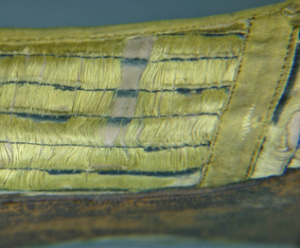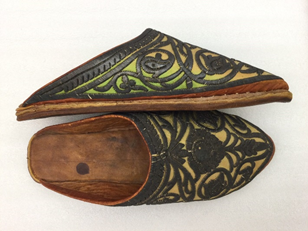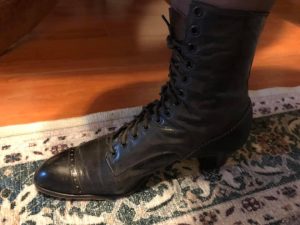Did you miss Ask a Conservator Day this year? Ask a Conservator Day is in remembrance of the flooding of Florence on November 4th, 1966, which damaged priceless cultural heritage. The social media campaign inspires conservators around the world to engage with each other to exchange knowledge and celebrate the growth of the field. Check out the answers to the questions you asked our conservator Ada below!
How do you think your role as a conservator will change as new innovations and technologies develop? (i.e. AR AND VR technology)
I haven’t had a chance to use either technology in artefact treatment at the BSM. However, I was watching a webinar presented by a UK conservator who used 3D printing to replace cleats that had totally disintegrated on a pair of football shoes. Textile conservators use digital printing on fabric to fill in large losses on historic clothing.
What does a conservator do? What projects are you working on?
I take care of the entire collection which includes many tasks. One major responsibility is how, where and under what conditions artefacts are stored. Preparing them for in-house exhibitions or for loans to other institutions. Monitoring the actual condition of the footwear with photographs and reports. Currently I’m getting a group of notable people’s shoes (2 of them are pictured below) ready for a loan to an exhibition at the Dutch Leather and Shoe Museum, Waalwijk, Netherlands.
How do you store your artefacts? Is temperature/humidity an issue?
We have several storage rooms which are climate controlled. The temperature and humidity are different in each room depending on the materials stored therein. The footwear sits on padded shelving, divided geographically, in chronological order, accompanied by their information cards. All the footwear is internally supported with archival material to help them hold their shapes. Special containers are made for items that require extra assistance. There are also cabinets with drawers housing 18th century shoe buckles, lithographs, shoemaker’s tools, guild certificates, fashion plates, etc.
Does the BSM offer conservation internships/co-op opportunities?
In the past, the museum has hosted interns as part of their conservation curriculum. Currently, with COVID social distancing, the lab does not have the space to accommodate 2 people. Hopefully, next year this will change. Here’s a before/after of a previous intern’s project which is described in greater detail in a conservation blog post that dropped on October 24th.
You’ve mentioned in the past about the difficulties of preserving plastics, is there anything you’re able to do as a conservator to slow down the deterioration process?
We are exploring this very issue! 20th century footwear and even more so, 21st century shoes have many plastic components which are challenging the traditional way museums house their collections. We are considering retro fitting an available room with a dedicated HVAC unit that will deliver cooler air and lower humidity levels.
Is it better to keep my footwear in shoeboxes? How does light affect them?
Keeping your footwear in the original box is a good idea. That way you can protect them from getting jumbled up at the bottom of your closet. You can also pile the boxes on top of each other but not so high that they collapse under their weight. If you have lots of shoes, take a photo and attach it to the exterior so you know what’s inside. Let your shoes air out overnight after each wear, then put tissue paper or even socks inside to help them hold their shape. Absolutely, light damage is cumulative, so if you have a pair of shoes you love and want to display make sure they are not in a sunny window! See the side effects below.
I recently purchased a pair of Victorian kid leather upper and regular leather base bottom portion boots. I noticed following handling them my hands were black which leads me to believe perhaps a prior owner used black shoe polish on them. What would you recommend? Try to remove polish or use something to buff out?
Without actually seeing them in person it’s hard to know what to say. It could be that the previous owner applied an overabundance of black polish or the surface of the leather could be powdering. You could try gently wiping the surface of the leather with a very soft, clean micro fibre cloth in an obscure test area on one of the boots (maybe the tongue or the heel).
I bought this pair of satin slippers and I think they are 1850s? Made in Paris. What is best way to keep them in shape? Stuff loosely with acid free tissue? Small padded shoe inserts? They are always kept in my glass curio display out of sunlight and rarely handled.
It’s great that you have them in a dust free cabinet. You could make your own padded inserts with a soft cotton knit (washed) and polyester batting. Be sure not to over stuff as it will distort their shape and in areas of stress, it will tear the satin. Acid free tissue paper is definitely another option. Manufactured shoe inserts can also cause damage; this is definitely not a case of one size fits all!
How old is your oldest pair of shoes? Are you ever nervous about handling objects from thousands of years ago?
A conservator needs to study the object in question, taking into consideration the condition of the materials and the stability of all the component elements before picking it up. For instance, the oldest pair of shoes in the collection, the sandals pictured below, have pegs through which a thong would have passed. All those pegs sitting in the holes are not permanently affixed and if not picked up with that taken into consideration, would fall out, possibly splintering if they fell on the floor.
How did you get into conservation? I struggle finding specific resources on how to get into the field.
I grew up with an interest in archaeology, art and art history, so conservation was a natural fit for me. This link will take you to a site that has a list of school programs available in Canada. Many countries have conservation programs if you wish to travel abroad.
Not shoes, but clothing related! I have inherited my great-Grandmother’s Japanese silk robe (not sure if it’s an actual Kimono but it is real silk), purchased on her year long honeymoon tour in the early 1920’s. It needs cleaning, but how? And I would like to display it, but again how without damaging or staining the fibers. Any advice would be so very welcome!
There are many options: T-stands, padded dowels, large shadowboxes, 2-sided display cases, there are even specially designed kimono stands. As this is a precious 100-year old family heirloom, I recommend you consult a textile conservator to help you through this process, especially if you want it cleaned first.


















